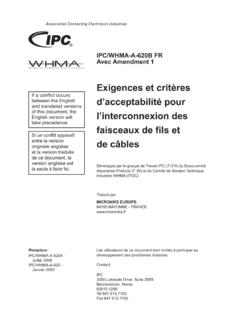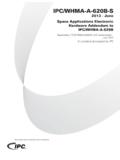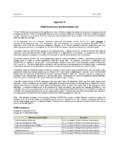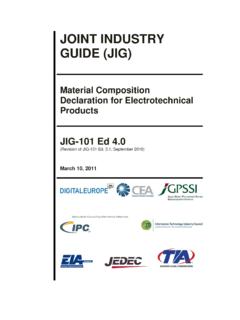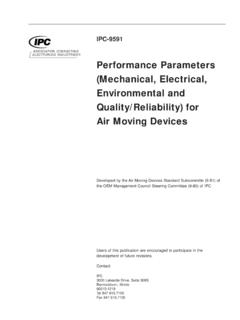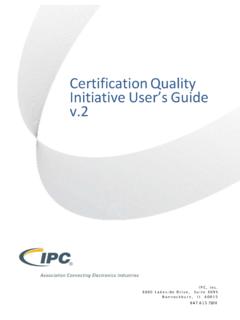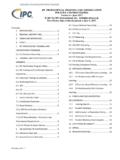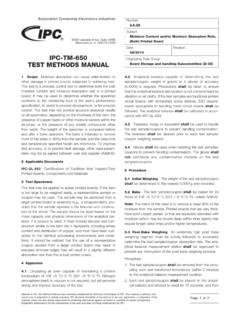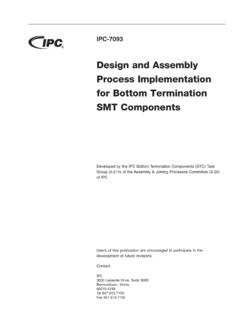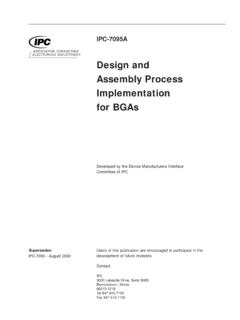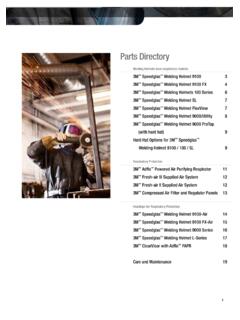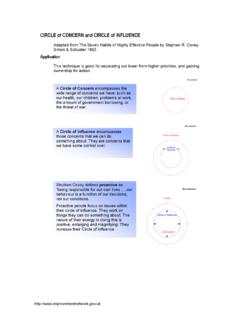Transcription of Standard for Visual Optical Inspection Aids - IPC
1 IPC-OI-645 Standard for VisualOptical Inspection AidsIPC-OI-645 Original PublicationOctober 1993 The Institute forInterconnectingand PackagingElectronic CircuitsA Standard developed by the Institute for Interconnectingand Packaging Electronic Circuits2215 Sanders RoadNorthbrook, Illinois60062-6135 TelFaxURL:847 of APPLICABLE .. Laboratories .. Terms and Requirements For All Inspection GradeSpecifications In This Standard .. Aid Inspection QUALITY ASSURANCE For Certification .. Of Recertification.
2 Procedures.. 6 AppendixesAppendix A 7 Appendix B Visual Resolving Power .. 10 Appendix C Magnifying aids .. 12 Appendix D Lighting Systems .. 14 Appendix E Typical Ways to Adjust andUse Instruments .. 15 Appendix F Certification Methods .. 21 Appendix G Projection or Video Magnifying TypeInstruments .. 37 Appendix H Automatic Inspection Systems .. 39 Appendix I References .. 40 FiguresFigure 1 Magnifying 2 Figure 2 Standard resolving power testtarget element .. 4 Figure A 1 Magnifying power of a simple device .. 8 Figure E 1 Typical zoom stereo microscope.
3 16 Figure E 2 Step 17 Figure E 3 Step 17 Firgure E 4a Step 18 Figure E 4b Step 18 Firgure E 5a Step 19 Figure E 5b Step 19 Firgure E 6a Step 20 Figure E 6b Step 20 Figure F 1 Magnascope calibration setup 24 Figure F 2 Magnascope 25 Figure F 3 Magnascope calibration by the masterlens 26 Figure F 4 Magnascope target configuration 27 Figure F 5 Master magnifier test setup 28 Figure F 6 Magnascope Telescope Reticle TestSetup 31 Figure F 7 Magnascope reticle and targetoverlay sketch .. 32 TablesTable 1 Quality Assurance 6 Table C 1 Magnifying aids Physical Propertiesfor Generic Type 12 Table C 2 Magnifying aids Operator Interfacefor Generic Type 13 Table D 1 Lighting Systems Operator Interfacefor Generic Type 14 Table D 2 Lighting Systems Operator Interfacefor Generic Type 14 Table F 1 Magnascope Calibration Equipment.
4 23 Table F 2 Master Lens Calibration 30 Table F 3 Master Lens Calibration Data and Resultsat 4X .. 33 Table F 4 Master Lens Calibration Data and Resultsat 10X .. 34 Table F 5 Magnascope Reticle Calibration Dataand 35 Table F 6 Magnascope Magnification 35 Table F 7 Calibration Error Parameters 36 Table F 8 4x Magnification Master Lensat 26 Inch Theodolite 36 Table F 9 Calibrating Magnascope by the TheodoliteCalibrated Target Method ( 5 Target) Calculated 36 October 1993 IPC-OI-645iiiStandard for Visual Optical Inspection ScopeThis Standard establishes the requirements,definitions, and certification provisions for Optical inspec-tion aids and defines Inspection grades that can be used asaccept/reject criteria for the instrumentation used in aninspection process that uses Optical Inspection PurposeThe intent of this document is to provideinformation to be used in the selection and application ofoptical magnifying Inspection aids .
5 It also provides specificpreferred wording and specific definitions of inspectiongrades to be used for Inspection operations requiring vary-ing degrees of Optical magnification Usage GradesThis specification provides Grades [Ithrough XII] to reflect progressive increases in magnifica-tion and resolution. These different grades indicate a pro-gression of increased usage complexity and applicationcost. The use of one grade for a specific acceptance testdoes not mean that other acceptance features must use thesame grade for acceptance.
6 Selection should be based onthe minimum needed to control required reliability. A gradeshould not be over specified, causing too-critical inspectionof the product without a real need for the added complex-ity and cost involved with increases in Certification TestThe certification for both the ini-tial qualification of the magnifying aid and the periodicquality conformance tests and methods are intended todemonstrate the ability of the Optical Inspection aid to meetthe requirements of this Standard . The examples used in theAppendices are not the only way this can be demonstrated,but are supplied as one of many acceptable ways.
7 Themethods defined in this Standard are supplied so users ofthis Standard not familiar with Optical technology applica-tions have a reference for APPLICABLE DOCUMENTSThe following documents, of the issue currently in effect,form a part of this document to the extent specified IPC1 IPC-T-50 Terms and Definitions for Interconnecting andPackaging Electronic Military2 MIL-STD-150 AMilitary Standard Photographic LensesMIL-STD-1241 AMilitary Standard Optical Terms andDefinitionsMIL-STD-1686 AElectrostatic Discharge Control Programfor Protection of Electrical and Electronic Parts, Assem-blies, and Equipment (Excluding Electrically InitiatedDevices)
8 Underwriters Standard 1581 Reference Standard for ElectricalWire, Cable, and Flexible Standard 153 Portable Related Terms and DefinitionsRelated definitionsand all terms used herein shall be as specified in IPC-T-50,MIL-STD-1241A, MIL-STD-150A, and MIL-STD-1686 Aor if not included in them, the definitions in this Apparent Field-Of-View AngleThe angular sub-tence of the field-of-view in the image space of the opticalsystem (the angle seen by the observer s eye) as differenti-ated from that in the object space (the real field).
9 Color TemperatureA measure of the energy dis-tribution over the visible spectral range ( , the color qual-ity) of a light source with a continuous spectrum expressedin Kelvins (K). The color temperature is the temperature onthe absolute scale (degrees C+273) to which a perfectblackbody radiator would have to be heated to appear visu-ally as the same color as the light source in Density, OpticalLogarithm to the base 10 of thereciprocal of DiopterAbbreviated DIOPT. A unit of refractivepower of a lens. In a lens or lens system it is numericallyequal to the reciprocal of the focal length measured inmeters.
10 For example, if a lens has a focal length of 25 cen-timeters, , 1/4 meter, its refractive power is 4 Publications may be obtained from the Institute for Interconnecting and Packaging Electronic Circuits, 2215 Sanders Road, Northbrook, IL Publications may be obtained from the Standardization Documents Order Desk, Building 4D, 700 Robbins Ave., Philadelphia, PA Publications may be obtained from Underwriters Laboratories, 333 Pfingsten Rd., Northbrook, IL 60062 October 1993 IPC-OI-6451
